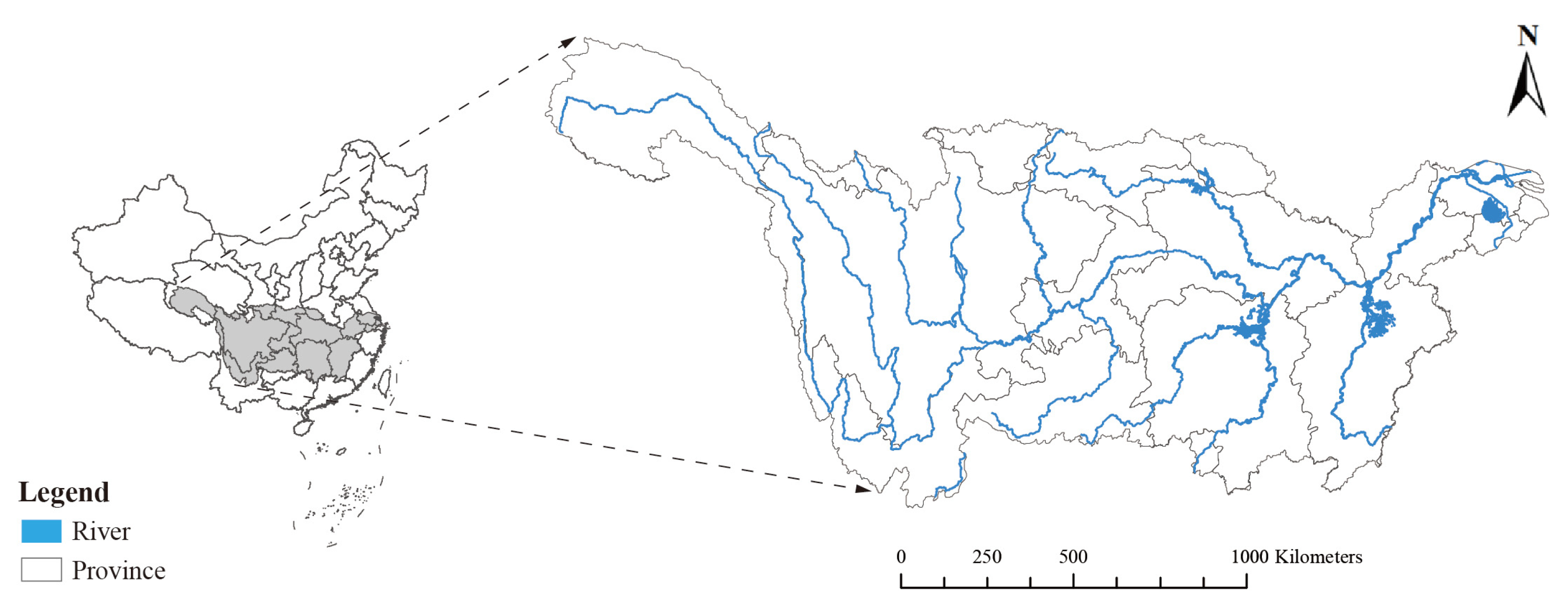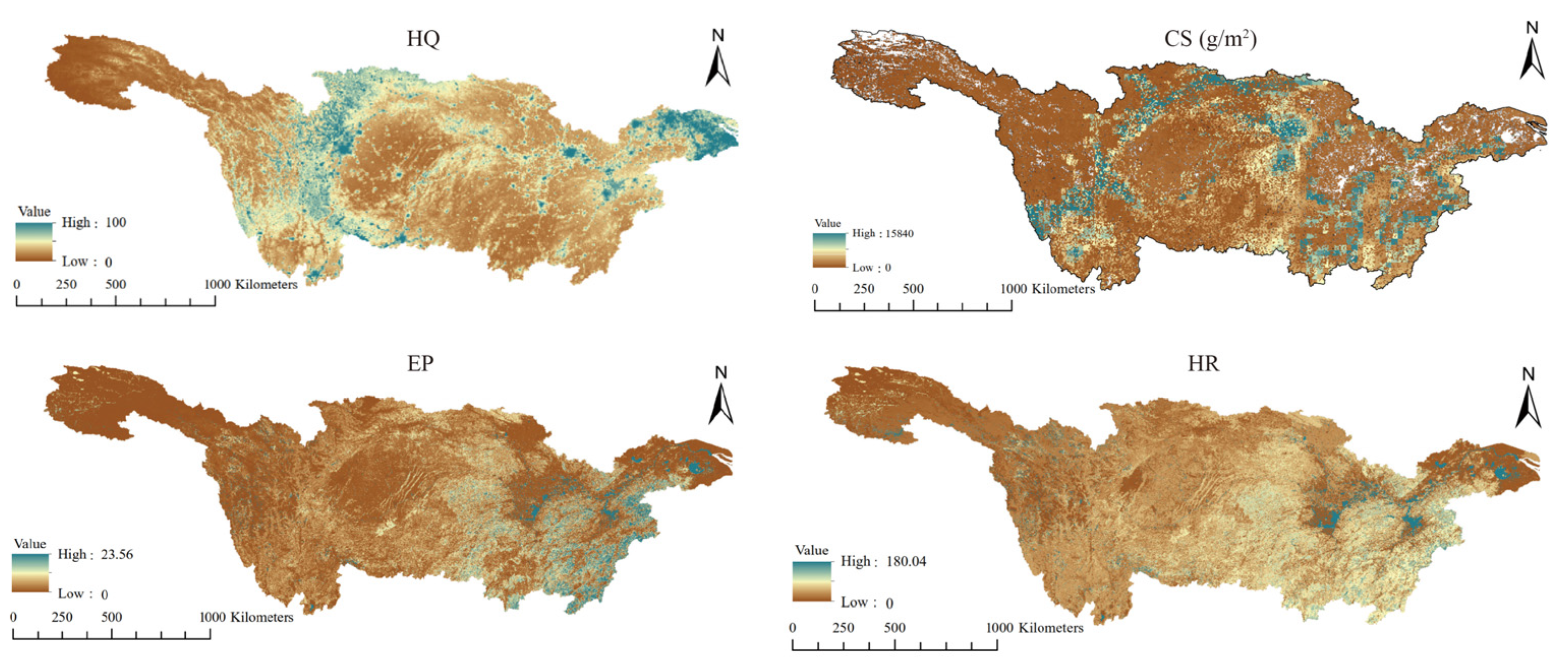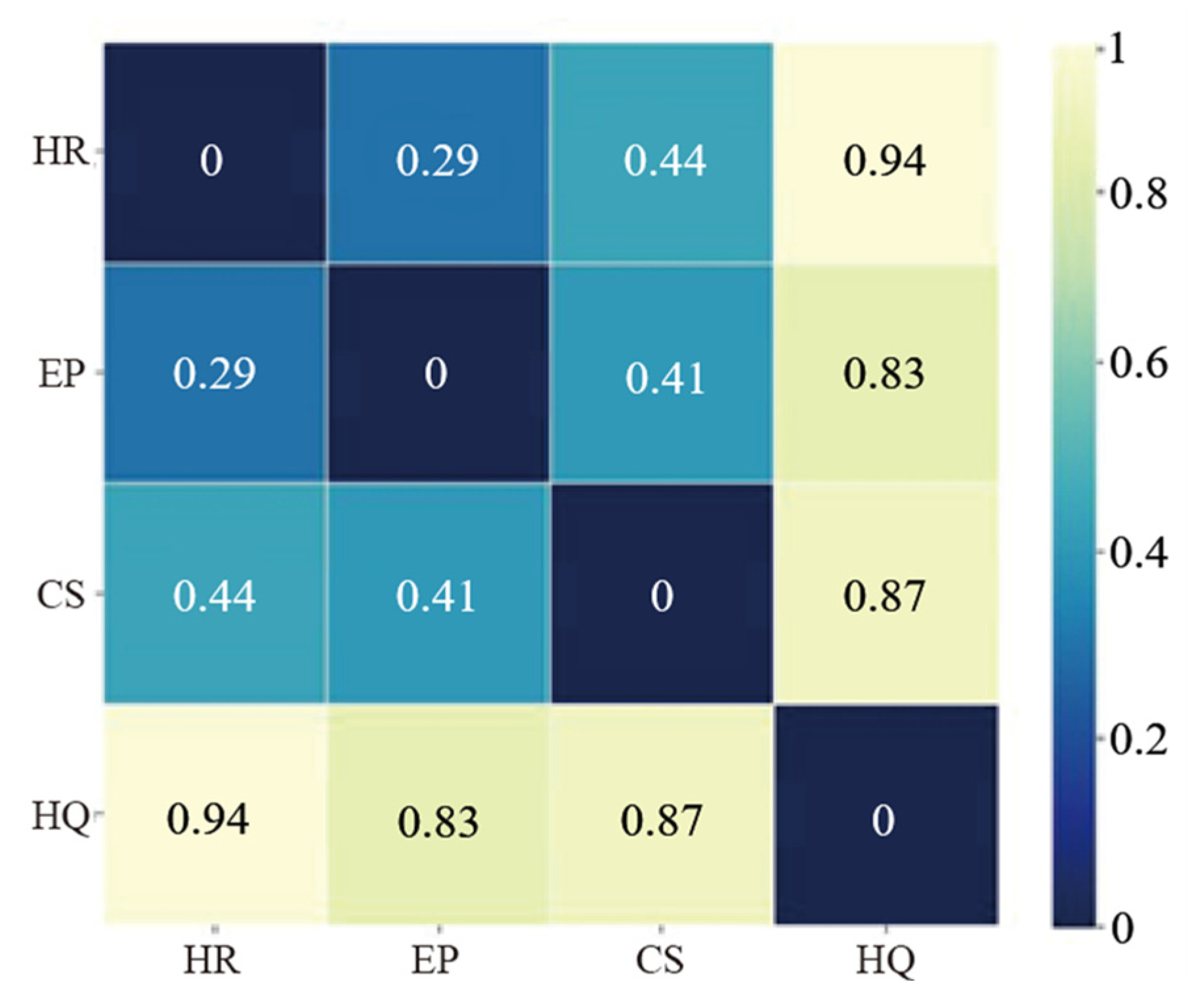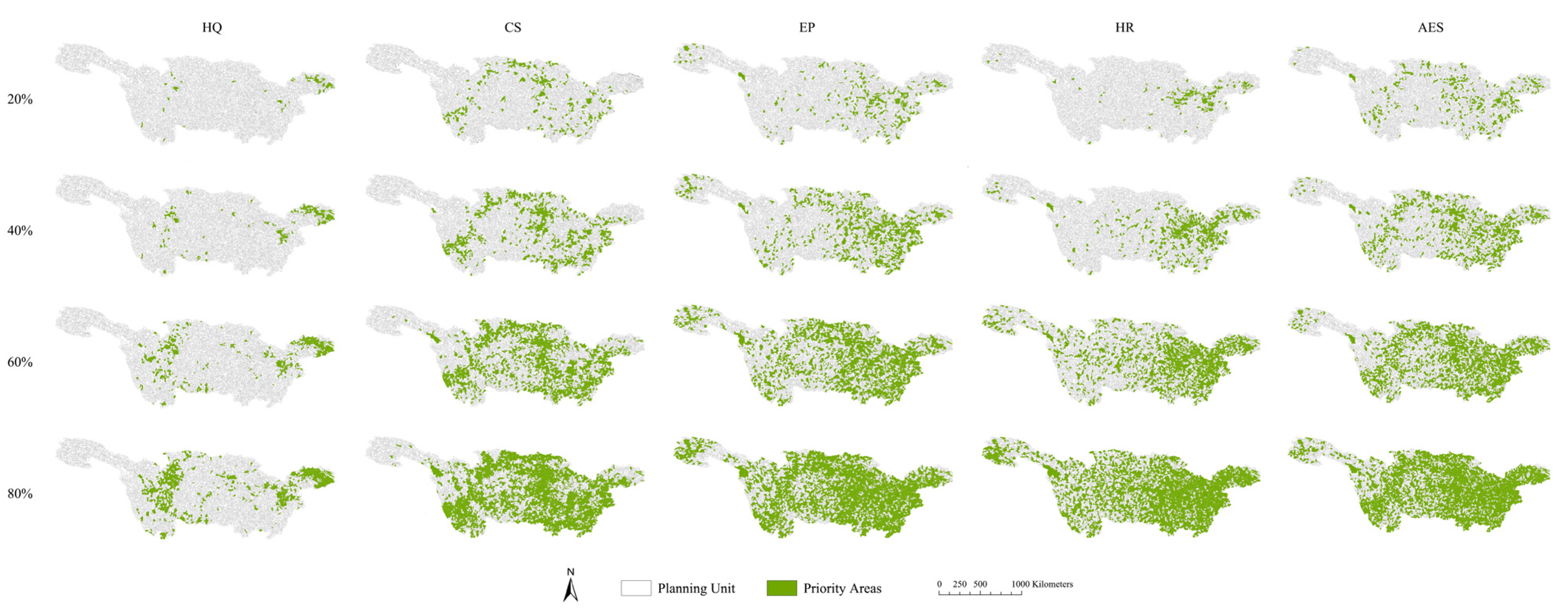Conservation Planning of Multiple Ecosystem Services in the Yangtze River Basin by Quantifying Trade-Offs and Synergies
Abstract
1. Introduction
2. Materials and Methods
2.1. Study Area
2.2. Data Sources
2.3. Estimation of Ecosystem Service Values
2.3.1. Habitat Quality
2.3.2. Carbon Storage
2.3.3. Environmental Purification and Hydrological Regulation
2.3.4. Analysis of Relationships among Ecosystem Services
2.4. Spatial Optimization
2.5. Measurement of the Similarity between Optimal Spatial Patterns
2.6. Statistical Analysis of Ecosystem Service Value Distribution
3. Results
3.1. Distribution and Trade-Offs of Ecosystem Service Supply Areas
3.2. Priority Areas for Ecosystem Service Conservation
4. Discussion
5. Conclusions
Author Contributions
Funding
Institutional Review Board Statement
Informed Consent Statement
Data Availability Statement
Acknowledgments
Conflicts of Interest
References
- Millennium Ecosystem Assessment (MEA). Ecosystems and Human Well-Being; Report of the Conceptual Framework Working Group of the Millennium Ecosystem Assessment; Island Press: Washington, DC, USA, 2003; p. 235. [Google Scholar]
- Steffen, W.; Richardson, K.; Rockström, J.; Cornell, S.E.; Fetzer, I.; Bennett, E.M. Planetary boundaries: Guiding human development on a changing planet. Science 2015, 347, 1259855. [Google Scholar] [CrossRef] [PubMed]
- Sutton, P.C.; Anderson, S.J.; Costanza, R.; Kubiszewski, I. The ecological economics of land degradation: Impacts on ecosystem service values. Ecol. Econ. 2016, 129, 182–192. [Google Scholar] [CrossRef]
- Dudley, N. Guidelines for Applying Protected Area Management Categories; IUCN: Gland, Switzerland, 2008. [Google Scholar]
- Goldman, R.L.; Tallis, H. A critical analysis of ecosystem services as a tool in conservation projects: The possible perils, the promises, and the partnerships. Ann. N. Y. Acad. Sci. 2009, 1162, 63–78. [Google Scholar] [CrossRef] [PubMed]
- Boulton, A.J.; Ekebom, J.; Gislason, G.M. Integrating ecosystem services into conservation strategies for freshwater and marine habitats: A review. Aquat. Conserv. 2016, 26, 963–985. [Google Scholar] [CrossRef]
- Hermoso, V.; Carvalho, S.B.; Giakoumi, S.; Goldsborough, D.; Katsanevakis, S.; Leontiou, S. The EU Biodiversity Strategy for 2030: Opportunities and challenges on the path towards biodiversity recovery. Environ. Sci. Policy 2022, 127, 263–271. [Google Scholar] [CrossRef]
- McCann, K.S. The diversity–stability debate. Nature 2000, 405, 228–233. [Google Scholar] [CrossRef]
- Balvanera, P.; Daily, G.C.; Ehrlich, P.R.; Ricketts, T.H.; Bailey, S.A.; Kark, S. Conserving biodiversity and ecosystem services. Science 2001, 291, 2047. [Google Scholar] [CrossRef]
- Chan, K.M.A.; Shaw, M.R.; Cameron, D.R.; Underwood, E.C.; Daily, G.C. Conservation planning for ecosystem services. PLoS Biol. 2006, 4, e379. [Google Scholar] [CrossRef]
- Egoh, B.; Rouget, M.; Reyers, B.; Knight, A.T.; Cowling, R.M.; Van Jaarsveld, A.S.; Welz, A. Integrating ecosystem services into conservation assessments: A review. Ecol. Econ. 2007, 63, 714–721. [Google Scholar] [CrossRef]
- Reyers, B.; Polasky, S.; Tallis, H.; Mooney, H.A.; Larigauderie, A. Finding common ground for biodiversity and ecosystem services. BioScience 2012, 62, 503–507. [Google Scholar]
- Ros-Cuéllar, J.; Porter-Bolland, l.; Bonilla-Moheno, M. Can Multifunctional Landscapes Become Effective Conservation Strategies? Challenges and Opportunities From a Mexican Case Study. Land 2019, 8, 6. [Google Scholar] [CrossRef]
- Archibald, C.L.; Dade, M.C.; Sonter, L.J.; Bell-James, J.; Boldy, R.; Cano, B.; Friedman, R.S.; Siqueira, F.F.; Metzger, J.P.; Fitzsimons, J.A.; et al. Do conservation covenants consider the delivery of ecosystem services? Environ. Sci. Policy 2021, 115, 99–107. [Google Scholar] [CrossRef]
- Margules, C.R.; Pressey, R.L. Systematic conservation planning. Nature 2000, 405, 243–253. [Google Scholar] [CrossRef] [PubMed]
- Juutinen, A.; Luque, S.; Mönkkönen, M.; Vainikainen, N.; Tomppo, E. Cost-effective forest conservation and criteria for potential conservation targets: A Finnish case study. Environ. Sci. Policy 2008, 11, 613–626. [Google Scholar] [CrossRef]
- Harrington, R.; Anton, C.; Dawson, T.P.; de Bello, F.; Feld, C.K.; Haslett, J.R. Ecosystem services and biodiversity conservation: Concepts and a glossary. Biodivers. Conserv. 2010, 19, 2773–2790. [Google Scholar] [CrossRef]
- Williams, B.A.; Grantham, H.S.; Watson, J.E.M.; Alvarez, S.J.; Simmonds, J.S.; Rogéliz, C.A.; Da Silva, M.; Forero-Medina, G.; Etter, A.; Nogales, J.; et al. Minimising the loss of biodiversity and ecosystem services in an intact landscape under risk of rapid agricultural development. Environ. Res. Lett. 2020, 15, 014001. [Google Scholar] [CrossRef]
- Merriam, G.; Ruzicka, M.; Hrnciarova, T.; Miklos, L. Proceedings of the First International Seminar on Methodology in Landscape Ecological Research and Planning; Roskilde Universitetsforlag: Roskilde, Denmark, 1984. [Google Scholar]
- Scott, J.M.; Davis, F.; Csuti, B.; Noss, R.; Butterfield, B.; Groves, C. Gap analysis: A geographic approach to protection of biological diversity. Wildl. Monogr. 1993, 123, 3–41. [Google Scholar]
- Mu, Y.L.; Li, X.W.; Guo, Y.; Liang, C.; Bai, J.; Linke, S.; Cui, B. Using climatic-geomorphological surrogates to identify complete and incidental freshwater conservation gaps within large river basins in China. Glob. Ecol. Conserv. 2021, 30, e01744. [Google Scholar] [CrossRef]
- Myers, N. The biodiversity challenge: Expanded hot-spots analysis. Environmentalist 1990, 10, 243–256. [Google Scholar] [CrossRef]
- Khoury, M.; Higgins, J.; Weitzell, R. A freshwater conservation assessment of the Upper Mississippi River basin using a coarse- and fine-filter approach. Freshw. Biol. 2011, 56, 162–179. [Google Scholar] [CrossRef]
- Ware, C.; Williams, K.J.; Harding, J.; Hawkins, B.; Harwood, T.; Manion, G.; Perkins, G.C.; Ferrier, S. Improving biodiversity surrogates for conservation assessment: A test of methods and the value of targeted biological surveys. Divers. Distrib. 2018, 24, 1333–1346. [Google Scholar] [CrossRef]
- Harrison, P.A.; Berry, P.M.; Simpson, G.; Haslett, J.R.; Blicharska, M.; Bucur, M.F. Linkages between biodiversity attributes and ecosystem services: A systematic review. Ecosyst. Serv. 2014, 9, 191–203. [Google Scholar] [CrossRef]
- Reside, A.E.; VanDerWal, J.; Moran, C. Trade-offs in carbon storage and biodiversity conservation under climate change reveal risk to endemic species. Biol. Conserv. 2017, 207, 9–16. [Google Scholar] [CrossRef]
- Agudelo, C.A.R.; Bustos, S.L.H.; Moreno, C.A.P. Modeling interactions among multiple ecosystem services. A critical review. Ecol. Modell. 2020, 429, 109103. [Google Scholar] [CrossRef]
- Li, G.; Cai, J. Spatial and Temporal Differentiation of Mountain Ecosystem Service Trade-Offs and Synergies: A Case Study of Jieshi Mountain, China. Sustainability 2022, 14, 4652. [Google Scholar] [CrossRef]
- Cardinale, B.J.; Duffy, J.E.; Gonzalez, A.; Hooper, D.U.; Perrings, C.; Venail, P. Biodiversity loss and its impact on humanity. Nature 2012, 486, 59–67. [Google Scholar] [CrossRef] [PubMed]
- Mouchet, M.A.; Lamarque, P.; Martín-López, B.; Crouzat, E.; Gos, P.; Byczek, C.; Lavorel, S. An interdisciplinary methodological guide for quantifying associations between ecosystem services. Glob. Environ. Change 2014, 28, 298–308. [Google Scholar] [CrossRef]
- Lamarque, P.; Lavorel, S.; Mouchet, M.; Quétier, F. Plant trait-based models identify direct and indirect effects of climate change on bundles of grassland ecosystem services. Proc. Natl. Acad. Sci. USA 2014, 111, 13751–13756. [Google Scholar] [CrossRef] [PubMed]
- Ricketts, T.H.; Watson, K.B.; Koh, I.; Ellis, A.M.; Nicholson, C.C.; Posner, S.; Richardson, L.L.; Sonter, L.J. Disaggregating the evidence linking biodiversity and ecosystem services. Nat. Commun. 2016, 7, 13106. [Google Scholar] [CrossRef] [PubMed]
- Watson, K.B.; Galford, G.L.; Sonter, L.J.; Koh, I.; Ricketts, T.H. Effects of human demand on conservation planning for biodiversity and ecosystem services. Conserv. Biol. 2019, 33, 942–952. [Google Scholar] [CrossRef] [PubMed]
- Pan, J.; Wei, S.; Li, Z. Spatiotemporal pattern of trade-offs and synergistic relationships among multiple ecosystem services in an arid inland river basin in NW China. Ecol. Indic. 2020, 114, 106345. [Google Scholar] [CrossRef]
- Dai, E.; Wang, X.; Zhu, J.; Tian, Q. Quantifying Co-Benefits and Trade-Offs between Forest Ecosystem Services in the Gan River Basin of South China. Sustainability 2022, 14, 8271. [Google Scholar] [CrossRef]
- Lemelin, L.V.; Darveau, M. Coarse and fine filters, gap analysis, and systematic conservation planning. For. Chron. 2006, 82, 802–805. [Google Scholar] [CrossRef]
- Thieme, M.; Lehner, B.; Abell, R.; Hamilton, S.K.; Kellndorfer, J.; Powell, G.; Riveros, J.C. Freshwater conservation planning in data-poor areas: An example from a remote Amazonian basin (Madre de Dios River, Peru and Bolivia). Biol. Conserv. 2007, 135, 484–501. [Google Scholar] [CrossRef]
- Fang, J.Y.; Guo, Z.D.; Piao, S.L.; Chen, A.P. Estimation of Terrestrial Vegetation Carbon Sink in China (in Chinese); Science China Press: Beijing, China, 2007; Volume 37, pp. 804–812. [Google Scholar]
- Zhang, C.; Ju, W.; Chen, J.M.; Zan, M.; Li, D.; Zhou, Y.; Wang, X. China’s forest biomass carbon sink based on seven inventories from 1973 to 2008. Clim. Chang. 2013, 118, 933–948. [Google Scholar] [CrossRef]
- Xie, G.D.; Zhang, C.X.; Zhang, L.M.; Chen, W.H.; Li, S.M. Improvement of the evaluation method for ecosystem service value based on per unit area. J. Nat. Resour. 2015, 30, 1243–1254. [Google Scholar]
- Ball, I.R.; Possingham, H.P. MARXAN (V1.8.2) User’s Manual. 2000. Available online: https://marxansolutions.org (accessed on 12 March 2000).
- Shi, M.; Wu, H.; Fan, X.; Jia, H.; Dong, T.; He, P.; Baqa, M.F.; Jiang, P. Trade-Offs and Synergies of Multiple Ecosystem Services for Different Land Use Scenarios in the Yili River Valley, China. Sustainability 2021, 13, 1577. [Google Scholar] [CrossRef]
- Sanon, S.; Hein, T.; Douven, W. Quantifying ecosystem service trade-offs: The case of an urban floodplain in Vienna. Austria. J. Environ. Manag. 2012, 111, 159–172. [Google Scholar] [CrossRef] [PubMed]
- Regos, A.; Hermoso, V.; D’Amen, M.; Guisan, A.; Brotons, L. Trade-offs and synergies between bird conservation and wildfire suppression in the face of global change. J. Appl. Ecol. 2018, 55, 2181–2192. [Google Scholar] [CrossRef]
- Cai, W. Identifying Ecosystem Services Bundles for Ecosystem Services Trade-Off/Synergy Governance in an Urbanizing Region. Land 2022, 11, 1593. [Google Scholar] [CrossRef]
- Kremen, C.; Ostfeld, R.S. A call to ecologists: Measuring, analyzing, and managing ecosystem services. Front. Ecol. Environ. 2005, 3, 540–548. [Google Scholar] [CrossRef]
- Lin, Y.P.; Lin, W.C.; Wang, Y.C.; Lien, W.Y.; Huang, T.; Hsu, C.C. Systematically designating conservation areas for protecting habitat quality and multiple ecosystem services. Environ. Model. Softw. 2017, 90, 126–146. [Google Scholar] [CrossRef]
- Wang, Y.S.; Zhao, Y. Spatial autocorrelations and scale effect of economy development in Henan, China. Geogr. Geo-Inf. Sci. 2015, 31, 69–72. (In Chinese) [Google Scholar]
- Lanzas, M.; Hermoso, V.; de-Miguel, S.; Bota, G.; Brotons, L. Designing a network of green infrastructure to enhance the conservation value of protected areas and maintain ecosystem services. Sci. Total Environ. 2019, 651, 541–550. [Google Scholar] [CrossRef] [PubMed]
- Lin, Y.P.; Chen, C.J.; Lien, W.Y.; Chang, W.H.; Petway, J.R.; Chiang, L.C. Landscape conservation planning to sustain ecosystem services under climate change. Sustainability 2019, 11, 1393. [Google Scholar] [CrossRef]
- Hermoso, V.; Cattarino, L.; Linke, S.; Kennard, M.J. Catchment zoning to enhance co-benefits and minimize trade-offs between ecosystem services and freshwater biodiversity conservation. Aquat. Conserv. 2018, 28, 1004–1014. [Google Scholar] [CrossRef]
- Bagstad, K.J.; Johnson, G.W.; Voigt, B.; Villa, F. Spatial dynamics of ecosystem service flows: A comprehensive approach to quantifying actual services. Ecosyst. Serv. 2013, 4, 117–125. [Google Scholar] [CrossRef]
- Villarreal-Rosas, J.; Sonter, L.J.; Runting, R.K.; López-Cubillos, S.; Dade, M.C.; Possingham, H.P.; Rhodes, J.R. Advancing systematic conservation planning for ecosystem services. Trends Ecol. Evol. 2020, 35, 1129–1139. [Google Scholar] [CrossRef]
- Yu, Y.; Wang, Y.; Li, J.; Han, L.; Zhang, S. Optimizing Management of the Qinling–Daba Mountain Area Based on Multi-Scale Ecosystem Service Supply and Demand. Land 2023, 12, 1744. [Google Scholar] [CrossRef]
- Goldman, R.L.; Tallis, H.; Kareiva, P.; Daily, G.C. Field evidence that ecosystem service projects support biodiversity and diversify options. Proc. Natl. Acad. Sci. USA 2008, 105, 9445–9448. [Google Scholar] [CrossRef]






Disclaimer/Publisher’s Note: The statements, opinions and data contained in all publications are solely those of the individual author(s) and contributor(s) and not of MDPI and/or the editor(s). MDPI and/or the editor(s) disclaim responsibility for any injury to people or property resulting from any ideas, methods, instructions or products referred to in the content. |
© 2024 by the authors. Licensee MDPI, Basel, Switzerland. This article is an open access article distributed under the terms and conditions of the Creative Commons Attribution (CC BY) license (https://creativecommons.org/licenses/by/4.0/).
Share and Cite
Mu, Y.; Wang, J.; Zhao, C.; Li, X.; Liu, Y.; Lv, J. Conservation Planning of Multiple Ecosystem Services in the Yangtze River Basin by Quantifying Trade-Offs and Synergies. Sustainability 2024, 16, 2511. https://doi.org/10.3390/su16062511
Mu Y, Wang J, Zhao C, Li X, Liu Y, Lv J. Conservation Planning of Multiple Ecosystem Services in the Yangtze River Basin by Quantifying Trade-Offs and Synergies. Sustainability. 2024; 16(6):2511. https://doi.org/10.3390/su16062511
Chicago/Turabian StyleMu, Yonglin, Jing Wang, Caisheng Zhao, Xiaowen Li, Yongbing Liu, and Jiangtao Lv. 2024. "Conservation Planning of Multiple Ecosystem Services in the Yangtze River Basin by Quantifying Trade-Offs and Synergies" Sustainability 16, no. 6: 2511. https://doi.org/10.3390/su16062511
APA StyleMu, Y., Wang, J., Zhao, C., Li, X., Liu, Y., & Lv, J. (2024). Conservation Planning of Multiple Ecosystem Services in the Yangtze River Basin by Quantifying Trade-Offs and Synergies. Sustainability, 16(6), 2511. https://doi.org/10.3390/su16062511




